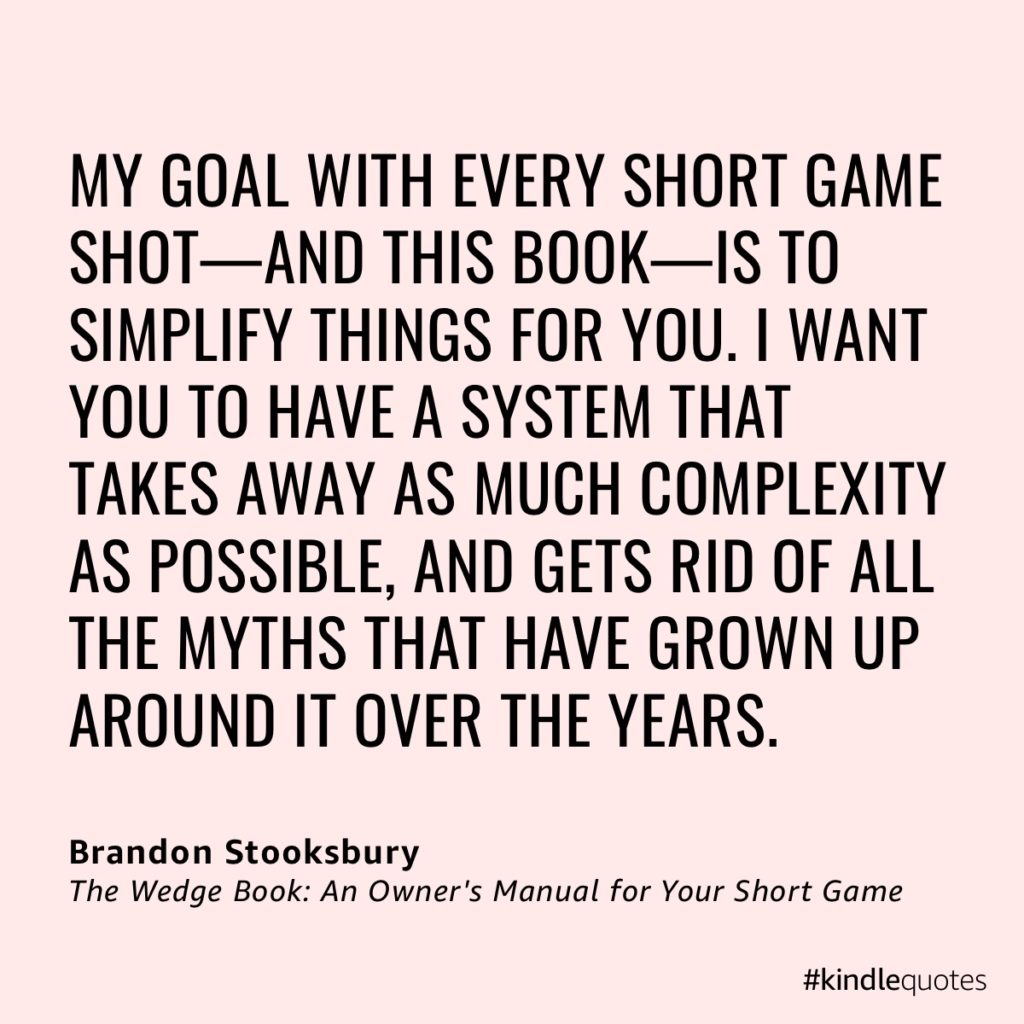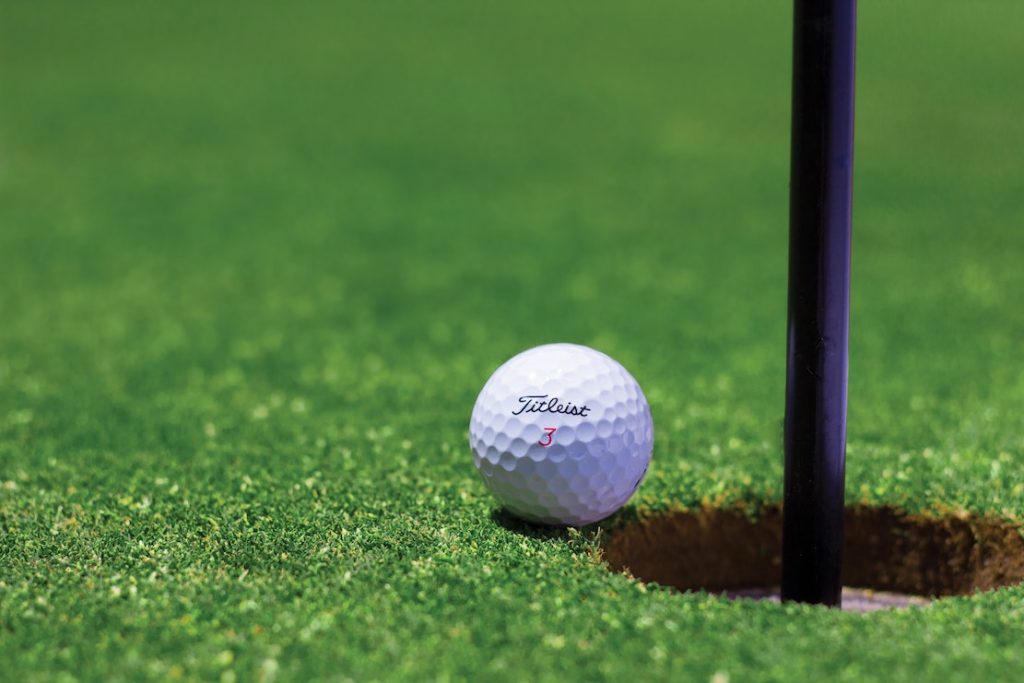As the title implies, The Wedge Book: An Owner’s Manual for Your Short Game sets out to provide golfers with the missing instruction manual for their short games. The book is written by Brandon Stooksbury, who has routinely been ranked as a Top 10 instructor in the state of Georgia. He currently is the PGA Director of Instruction at the Idle Hour Club in Macon, GA.

At Idle Hour, Stooksbury provides instruction to all levels of golfers. He has honed his teaching in on the short game and putting because this is the area where there is the most room for improvement in player’s games. The majority of shots in a golf round happen from about 100 yards and in.
Whether you are scoring in the 70s or above 100, roughly 70% of your shots occur from 100 yards and in. Most amateurs and weekend golfers spend the least amount of their practice time improving this area of their game. And if they do receive professional instruction, often the short game and putting lesson is thrown in at the end of a long session of hitting balls and the instruction is some version of, “Just do what feels right for yourself.”
The Short Game Simplified
Stooksbury set out to simplify the short game, and in that way, he was very successful. The book is around 100 pages, but probably around 1/3 of that is spent on pictures, the introduction, and the acknowledgments in the back. This book could easily be read in about an hour. Of the actual instruction, there are only around 20 pages or so to absorb.

The author makes the point that the first thing players need to do is create a plan for their short game shots. That plan includes determining what kind of lie you have, picking out the landing zone, “standing to the handle”, and matching both sides of your swing.
“Standing to the handle” means first setting the club behind the ball, with any forward or backward shaft lean you may want on the shot. After you set the club, you “stand to the handle” so it is in a natural position in front of your body. Stooksbury says he sees many amateurs first setting their bodies on short game shots, then leaning the shaft forward or backward which causes the body to contort in unnatural ways. This contorting is what many times cause shots to be hit fat or thin. By standing to the handle, you will be able to make a natural swing and the low part of the swing will be when your hands are naturally at the lowest point in front of your body. This simplification should help eliminate fat or thin shots.
Matching both sides of your swing just means mirroring your backswing to your forward swing. If you take the club back six inches on your backswing, you should only bring it 6 inches forward on your forward swing. It is another lesson designed to simplify the short game shots. By mirroring your swings, you will develop good tempo through your short game shots and hopefully eliminate fat and thin shots that come when players overly accelerate through their swings.
Different Short Game Shot Types
With this foundation of basic short game techniques, Stooksbury now starts to build the different shots that players will have to hit. All of the shots include you determining the landing zone, standing to the handle, and matching both sides of your swing.
We start closest to the green with the bump and run shot. The author explains how to determine the proper landing zone, when to implement shaft lean (to either increase or decrease the loft of the club), and when to change clubs entirely.
Next up is the “hinge and hold” shot. You would hit this shot when you are further back from the green and need to carry the ball further. You keep the same set up as the bump and run shot, but bring your arms further back and hinge your wrists before the forward swing.
This is also the point in the book where the instruction gets a little hard to follow. There are no diagrams to follow in the book. And only a few pictures after each chapter showing the proper and improper way to perform the shots he describes. The book could use some more diagrams and pictures in this section.
The next shot discussed is the toss shot. This is for when you are even further away from the green. You get the shoulder rock of the bump and run, the wrist hinge of the “hinge and hold”, and more arm action like you were making an underhand toss of a softball.

The Bunker Shot
This chapter was the star of the show for me. As many of my playing partners know, my bunker game is by far my weakest and the most unreliable part of my game. So it was with great interest that I read this chapter.
Those big, splashy type of bunker shots that you see the pros hit are just too complicated for most amateurs to regularly get right. It takes a lot of practice, and a lot of feel for the sand to get those shots out of the sand and close to the hole. Again, Stooksbury tries to simplify the bunker shot into simple and repeatable steps you can take to get out of the sand. And hopefully, you roll your ball close to the hole and get one of those lovely sandy pars.
The key to his bunker approach is to set up your stance to, “take a thin, shallow skim of sand.” You play the ball forward in your stance and lean the shaft back. Then stand to the handle and open the clubface slightly (the grooves in the clubface should point at your front foot). Then take your normal toss shot swing and aim to hit the sand before your ball. Take a long, thin skim of sand and the ball should fly out of the bunker and have some spin on it to stop relatively easily.
You can control the distance and how hard you swing based on club selection. You don’t have to exclusively use your sand wedge because you aren’t taking one of those big, splashy swings. You don’t need to rely on the bounce of the club to get the ball out of the sand.
Conclusion
Stooksbury does deliver on his promise to simplify the short game. He gives you easy-to-follow instructions on your pre-shot plan (picking a landing zone, standing to the handle). And also give simple instructions on implementing different shots depending on how far you are from your desired landing zone or the hole.
But, the book is also lacking some details that would make the different types of shots easier to understand. The book definitely could have used some diagrams and more images to get his points across. A common complaint is that this book seems like the Cliff’s Notes version of a much longer short game book.
Like most things in golf (and life), you only will develop the skills you want with a guide and lots of practice. This book does provide the building blocks of a simple, repeatable short game. But it is up to you to get out there and practice them.
I would recommend The Wedge Book to most weekend golfers that maybe haven’t been practicing their short game as they should be. I’m guilty as charged there too. At 100 pages or so, it is easy enough to read that even if you don’t follow everything the author says, you will pick up a couple of tips that you can bring with you on your next trip to the chipping green.




